Saturday, September 14. Today we were going to Bethlehem. Bethlehem, of course, is where
Jesus was born. We had breakfast at 6:45 and our bus left at 8:15. Traffic was a little lighter
because this was early on the Sabbath but, with going through a checkpoint, the six-mile trip still
took nearly an hour. The checkpoint was necessary because Bethlehem is in the West Bank (Zone
A, where the Palestinian Authority is in charge of internal security). Being so
close to Jerusalem, Bethlehem normally would have been swallowed up by the
larger city, or at least have become a contiguous suburb. But the tall
Israeli wall begun in 2002 effectively cuts off direct access between them
except through the Iraeli checkpoint.
Tourism to Bethlehem
is very important for the Palestinians. It
provides a decent income to a limited number
of them, and they seem eager to prevent any
sign of hostility or unrest that might deter
tourists. But it is not all roses. Most
tourists (like us) just visit the Church of
the Nativity and the Shepherds' Field, use
the toilets, maybe visit a crafts shop and
have lunch. Then they leave. An overnight
tourist would probably spend three times
what a day-tripper does. Even so, with 1.5
million tourists a year, even if they stay
for only a few hours, it does add up.
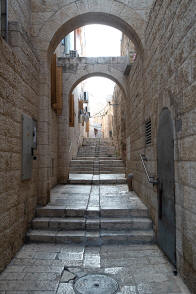
Lane in Bethlehem |
Not surprisingly, we
were required to have a Palestinian guide.
We picked him up shortly after our arrival
in Bethlehem. He gave us an orientation in a
cave such as Jesus might have been born in.
(There are many such caves in the area, and
no one claimed that this particular on had
any connection to Jesus.) Then he lead us to
an area with benches overlooking a valley
designated as Shepherds' Field, supposedly
the spot where angels first announced Jesus'
birth.
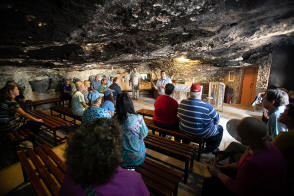
Briefing in a cave | 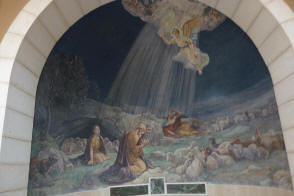
Angels appear to shepherds |
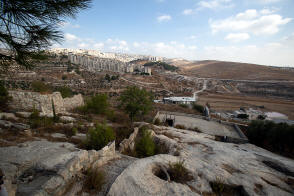
Shepherds' Field (left) |
We had a group meditation session there before taking
the bus to Manger Square near the center of the city. The Square is a large
open area surrounded by important buildings. On the Palestinian side (west),
this includes the Municipal Building, the Mosque of Omar (1860) and the
Bethlehem Peace Center. The east side is filled with Christian sites,
primarily the Church of the Nativity, but the complex also contains the
Chapel of St. Catherine (local parish church) and three different
monasteries,one Greek Orthodox, one Armenian Apostolic, and one Roman
Catholic).

Manger Square (view west) | -armenian(R)_small.jpg)
Manger Square (view east) |

Entrance to Nativity Church |
The original Church
of the Nativity was built in about 333 A.D. by Emperor Constantinet over the
cave in which Jesus is believed to have been born. That church was burned, and the present
church was built by Emperor Justinian in about 565 on the same site. There have
been changes over the centuries, mostly
additions, and a major restoration to
counter deterioration was just completed in
2019.
Our group was not able to enter the Church when we arrived there at 10:30, so we spread out
along the wall of the courtyard where there was a bit of shade. We were admitted after about 15
minutes. About 10% of the pre-1200 A.D.on the walls have been restored, as well
as some of the original 4th century mosaic floor, now a few feet beneath the present floor. (There were openings through which to view those.)
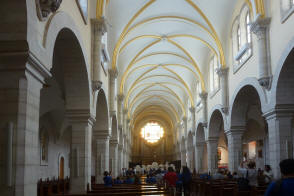
Nave of Nativity Church | 
Surviving
medieval mosaics |
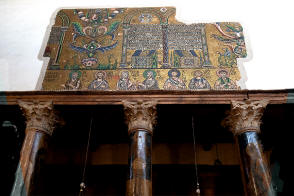
Surviving
medieval mosaics |
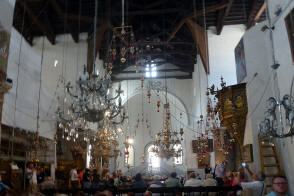
Lamps inside church |

Original mosaic floor |

Guide informs our group |
Naturally, the Grotto of the Nativity was on the lower floor. The “exact spot” of the birth was
marked by a large silver star under the Altar of theNativity. Also on the lower floor was the Cave of St. Jerome.
This is where Jerome translated the Bible from Greek and Hebrew into Latin between 382-404
A.D. This was the Latin Vulgate version of the Bible. It was then used around the world for
centuries.

Briefing in the cave | 
Altar of the Nativity with star |

Plaque to St. Jerome |
Our group left the Church about 11:40 and walked to a nearby restaurant for lunch. From there
we walked to an olive wood carving shop. It had many very large, intricate and expensive
carvings, as well as the cheap stuff for tourists. We left Bethlehem at 1:35.
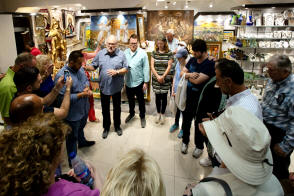
In the olive wood shop | 
Artesan shaping figures |

Large & ornate nativity scene |